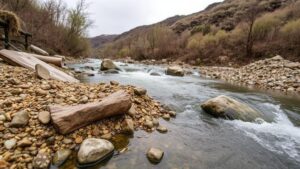Techniques for Locating Rich Pay Streaks in Abandoned River Channels
Techniques for Locating Rich Pay Streaks in Abandoned River Channels
The search for gold and other valuable minerals has long captivated prospectors and geologists alike. Among the most promising locations for such endeavors are the abandoned river channels that once served as active waterways rich in mineral deposits. This article explores various techniques that can be employed to identify rich pay streaks in these areas, providing both historical context and modern methodologies that can yield successful results.
Understanding Abandoned River Channels
An abandoned river channel is a waterway that has ceased to flow due to shifts in geological or hydrological factors. Over time, these channels can fill with sediments that bear minerals, including gold. Understanding the formation of these channels is essential for prospectors. For example, the process of erosion and sediment transport, combined with the natural meandering of rivers, plays a critical role in the deposition of minerals.
Techniques for Locating Pay Streaks
Several techniques can be used to locate rich pay streaks within abandoned river channels. e methods range from traditional prospecting to advanced geological surveying, each with its merits and applications.
- Topographic Mapping: Utilizing topographic maps can help identify the historical flow of rivers. By studying these maps, prospectors can pinpoint areas where deposition is likely to have occurred, leading to discoveries of rich deposits.
- Aerial Surveys: The use of aerial photography and satellite imagery can reveal changes in landforms indicative of past river activity. Advancements in drone technology provide detailed views that can highlight potential pay streak locations.
- Geophysical Surveys: Techniques such as resistivity and ground-penetrating radar (GPR) can be employed to visualize subsurface structures and identify areas with anomalously high mineral content. For example, GPR is especially effective in differentiating between various types of sediment.
- Soil Sampling: Systematic soil sampling in suspected locations can reveal the presence of gold and other minerals. By analyzing the concentration of these materials, prospectors can assess the potential richness of the area.
- Hydraulic Sluicing: Useing hydraulic sluicing techniques allows for the efficient capture of minerals from sediment-laden water. This method can be particularly effective in areas with loose, water-saturated sediment.
Case Studies
Historically, significant gold strikes in abandoned river channels serve as illustrative examples of successful prospecting techniques. Klondike Gold Rush (1896-1899) is a compelling case where prospectors utilized both physical and geological knowledge to locate rich deposits in the icy river beds of Yukon, Canada. Modern methods have enhanced this process; for example, extensive geological surveys have been employed to map the old channels and indicate high-potential locations.
Challenges and Considerations
While prospecting for pay streaks in abandoned river channels can be rewarding, it also poses several challenges. Regulatory frameworks often govern mineral extraction, necessitating thorough research to ensure compliance. Also, environmental considerations are paramount. Miners must remain cognizant of the potential impacts on local ecosystems and water quality.
Conclusion
Locating rich pay streaks in abandoned river channels combines traditional prospecting knowledge with modern technology. By employing techniques such as topographic mapping, geophysical surveys, and hydraulic sluicing, prospectors can maximize their chances of rediscovering valuable mineral resources. As this field continues to evolve, ongoing education and technological integration will be essential for sustainable and successful mineral exploration in these untapped regions.
Actionable Takeaways
- Familiarize yourself with the history and formation of river channels in your area.
- Invest in modern surveying technologies, such as drones or GPR, to enhance exploration efforts.
- Adhere strictly to regulations and prioritize environmental stewardship in all prospecting activities.


